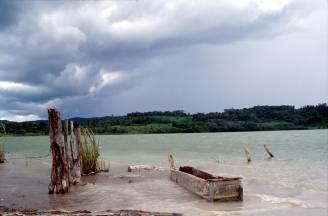geotimesheader
News Notes
Mayan
days wet but not rainy
 Tickling out human-induced
changes from climate records has often been a tortuous game for scientists.
Now researchers working in ancient Mayan stomping grounds are warning that
in some cases climate records may be an illusion, recording instead the
human touch.
Tickling out human-induced
changes from climate records has often been a tortuous game for scientists.
Now researchers working in ancient Mayan stomping grounds are warning that
in some cases climate records may be an illusion, recording instead the
human touch.
Lake Salpetén in Petén, Guatemala, is a small lake, only
30 meters deep, that has often been used as a major water source. Those
living in the lowland depended on the lake and its bigger neighbor, Lake
Petén Itzá, with 150-meter depths, for their families and
farms. The lakes lay in the middle of the Mayan heartland, says Michael
Rosenmeier of the University of Florida.
[At right: Remnants of a pier along the shores
of Lake Salpetén. Michael Rosenmeier]
Although enormous populations were subsisting around both lakes, the
smaller Lake Salpetén was more sensitive to changes occurring along
its banks. At a meeting of the American Geophysical Union on Dec. 15, Rosenmeier
and colleagues showed how human deforestation within the watershed has
confounded climate reconstructions.
“What you see in these records is not necessarily wet or dry in the
sense of a climatic wet or dry, drought vs. increased rainfall,” Rosenmeier
says. The researchers compared the oxygen isotope record from sediment
cores in the lake with pollen records and saw a clear link between inferred
“wet” periods and deforestation. “As you remove that forest did not impact
the watershed. cover you have a lot more surface runoff directly
into the lake,” he says.
The records reach back 400 years prior to Mayan occupation, when a lush,
green canopy of Moraceae trees sopped up rainfall from the soil like a
sponge. In response, the lake recorded conditions that were drought-like
in comparison to its later deforested days.
Much of the controversy surrounding the Mayan culture is what caused
their demise. At the same AGU meeting Richardson Gill, an independent anthropologist
in San Antonio, Texas, blamed the downfall on drought. Other studies have
looked at isotopic records from lakes in northern Yucatán, where
occupation did not affect the watershed.
Although Rosenmeier agrees that drought may have been responsible for
the demise of the Mayas, he cautions that environmental degradation was
also a factor. At the time of the Mayan collapse in the ninth century,
the record from Lake Salpetén again showed the forest recovering
and causing drought-like conditions.
As more isotopic studies begin to emerge from the tropics it will be
critical to keep in mind how human activities influence the climate record,
Rosenmeier says. In the case of Lake Salpetén, “it’s a red flag.”
Christina Reed
 Tickling out human-induced
changes from climate records has often been a tortuous game for scientists.
Now researchers working in ancient Mayan stomping grounds are warning that
in some cases climate records may be an illusion, recording instead the
human touch.
Tickling out human-induced
changes from climate records has often been a tortuous game for scientists.
Now researchers working in ancient Mayan stomping grounds are warning that
in some cases climate records may be an illusion, recording instead the
human touch.
